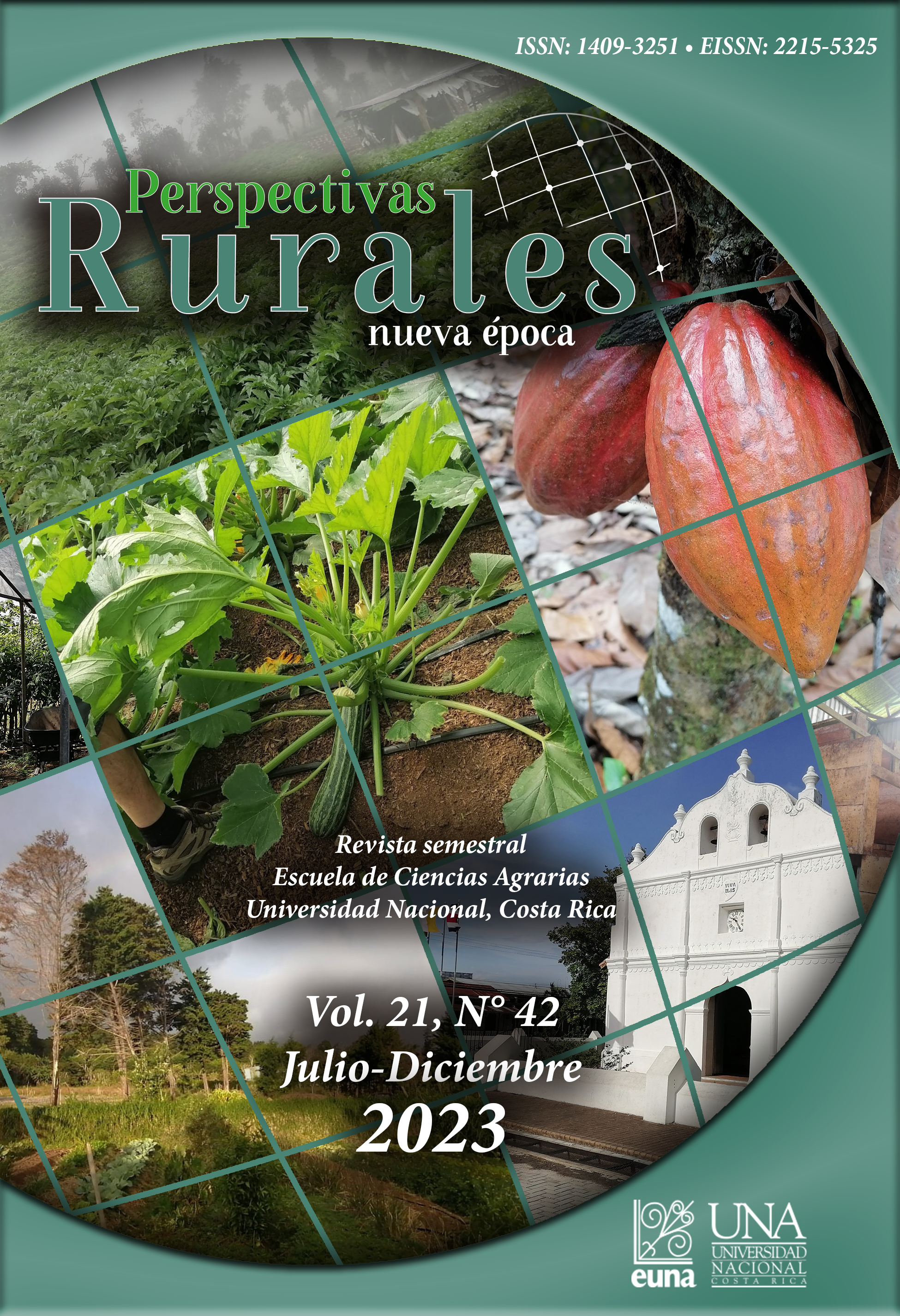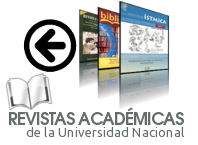Threat to food security in the Apatlaco river sub-basin (Mexico)
Architectural and urban paradigm effect of the drainage and sewerage infrastructure design
DOI:
https://doi.org/10.15359/prne.21-42.1Keywords:
Urban wastewater, food security, Apatlaco river sub-basinAbstract
The Apatlaco is considered one of the most polluted sub-basins in Mexico. Consequently, a federal lawsuit has been filed since 2016 against the 11 municipalities that comprise the sub-basin by “Morelos Inhabitants”, which requires detecting and stopping any type of irregular untreated wastewater discharge into surface water bodies. The objective of this paper is to analyze the incidence of the logic of contamination with untreated wastewater in the sub-basin of the Apatlaco River, Morelos, Mexico that threatens food security due to the irrigation of its surrounding agricultural areas. Wastewater conditions were analyzed based on a territorial unit (Cuernavaca), including the identification and calculation of discharge points distributed by land use. Based on the territorial unit, the residual effluent generated by the 11 municipalities that comprise the sub-basin was calculated, considering the expenditure per capita, inhabitants per municipalities, the percentage with respect to the total state population and the one in the sub-basin. Finally, the Apatlaco agricultural area and current lines were identified to determine the susceptibility of the use of wastewater in food production.
References
Batllori, A. (2001). Los problemas ambientales del Estado de Morelos: la educación como parte de la solución. Gaceta ecológica,(61), 47-60.
Bellamy, J. (2000). La ecología de Marx. Materialismo y naturaleza: traducción de Carlos Martin y Carmen González. Ediciones de Intervención Cultural el Viejo Topo.
Cantoni N. (2009). “Técnicas de muestreo y determinación del tamaño de la muestra en investigación cuantitativa”, Revista Argentina de Humanidades y Ciencias Sociales, 7 (2), 1-5, https://www.sai.com.ar/metodologia/rahycs/rahycs_v7_n2_06.htm
Comisión Nacional del Agua. (2016). Situación del subsector agua, drenaje y saneamiento. https://www.gob.mx/cms/uploads/attachment/file/184667/DSAPAS_2016_web_Parte1.pdf
Dorfman, M. (2004). Swimming in sewage: The Growing Problem of Sewage Pollution and How the Bush Administration Is Putting Our Health and Environment at Risk. Natural Resources Defense Council and Environmental Integrity Project. https://search.issuelab.org/resource/swimming-in-sewage-the-growing-problem-of-sewage-pollution-and-how-the-bush-administration-is-putting-our-health-and-environment-at-risk.html
Food and Agricultural Organization. (2002). Agua y cultivos. Logrando el uso óptimo del agua en la agricultura. https://www.fao.org/3/Y3918S/y3918s.pdf
Food and Agricultural Organization. (2011). El estado de los recursos de tierras y aguas del mundo para la alimentación y la agricultura: cómo gestionar los sistemas en peligro. https://www.fao.org/3/i1688s/i1688s.pdf
Food and Agricultural Organization. (2015). El estado mundial de la agricultura y la alimentación. La protección social y la agricultura: romper el ciclo de la pobreza rural. https://www.fao.org/3/i4910s/i4910s.pdf
Food and Agricultural Organization. (2016). Migración, agricultura y desarrollo rural: Abordar las causas subyacentes de la migración y aprovechar su potencial para el desarrollo. https://www.fao.org/3/i6064s/i6064s.pdf
Food and Agricultural Organization. (2020). El estado mundial de la agricultura y la alimentación 2020. Superar los desafíos relacionados con el agua en la agricultura. https://doi.org/10.4060/cb1447es
Food and Agricultural Organization. (2021). El estado de los recursos de tierras y aguas del mundo para la alimentación y la agricultura - Sistemas al límite informe de síntesis 2021. https://doi.org/10.4060/cb7654es
Gobierno Municipal de Cuernavaca. (2016-2018). Programa de desarrollo urbano de centro de población de Cuernavaca. Carta Urbana de Cuernavaca. https://www.cuernavaca.gob.mx/?page_id=8601
González, M. y Chiroles, S. (2011). Uso seguro y riesgos microbiológicos del agua residual para la agricultura. Revista Cubana de Salud Pública, 37 (1), 61-73. https://www.redalyc.org/articulo.oa?id=21417788007
Instituto Nacional de Estadística y Geografía. (2010). Red hidrográfica. Escala 1:50 000. Edición 2.0. Subcuenca hidrográfica RH18Fd R. Apatlaco. Cuenca R. Grande de Amacuzac. R. H. Balsas. https://www.inegi.org.mx/contenidos/productos/prod_serv/contenidos/espanol/bvinegi/productos/geografia/hidrogeolo/subcuencas_2.0/889463129837_s.zip
Instituto Nacional de Estadística y Geografía. (2016). Manchas urbanas y rurales, 2015, escala: 1:250000. Geoportal del Sistema Nacional de Información sobre Biodiversidad. http://www.conabio.gob.mx/informacion/gis/?vns=gis_root/dipol/mupal/mun22gw
Instituto Nacional de Estadística y Geografía. (2020). Descarga masiva: manzanas 2020. Sistemas de consulta. https://www.inegi.org.mx/contenidos/masiva/indicadores/inv/17_Manzanas_INV2020_shp.zip
Instituto Nacional de Estadística y Geografía. (2020a). Número de habitantes por municipio. Información de México para niños. https://cuentame.inegi.org.mx/monografias/informacion/mor/poblacion/
Instituto Nacional de Estadística y Geografía. (2021). Conjunto de datos vectoriales de uso de suelo y vegetación. Escala 1:250 000, Serie VII. Geoportal del Sistema Nacional de Información sobre Biodiversidad. http://www.conabio.gob.mx/informacion/gis/?vns=gis_root/usv/inegi/usv250s7gw
Instituto Nacional de Estadística y Geografía. (2022). División política municipal, 1:250000. Geoportal del Sistema Nacional de Información sobre Biodiversidad. http://www.conabio.gob.mx/informacion/gis/?vns=gis_root/dipol/mupal/mun22gw
Montes G. M., Monroy-Ortiz R. (2020). Ravines of “Eternal Spring,” the Second Drainage System of Cuernavaca. In: Otazo-Sánchez E., Navarro-Frómeta A., Singh V. (eds) Water Availability and Management in México. Water Science and Technology Library, vol 999. Springer, Cham.
Peña, F. (2011). Problemas sociales en la utilización de aguas residuales urbanas en la agricultura. En Spring, O., U. (ed.), 2011. Retos de la investigación del agua en México. Universidad Nacional Autónoma de México.
Pérez, I. (2015). Las “aguas negras” y sus beneficios. Ambiente y Naturaleza. http://ciencia.unam.mx/leer/425/Las_%E2%80%9Caguas_negras%E2%80%9D_y_sus_beneficios
Programa de las Naciones Unidas para el Desarrollo. (2019). Objetivo 2: poner fin al hambre. https://www.un.org/sustainabledevelopment/es/hunger/
Secretaría de Medio Ambiente y Recursos Naturales. (2008). La cuenca del río Apatlaco: recuperemos el patrimonio ambiental de los morelenses. http://centro.paot.org.mx/documentos/semarnat/cuenca_rio_apatlaco.pdf
Servicio de Información Agroalimentaria y Pesquera. (2020). Estadística de producción agrícola. http://infosiap.siap.gob.mx/gobmx/datosAbiertos.php
Servicio de Información Agroalimentaria y Pesquera. (2021). Panorama agroalimentario 2021. https://nube.siap.gob.mx/gobmx_publicaciones_siap/pag/2021/Panorama-Agroalimentario-2021
Shiva, V. (2003). Las guerras del agua. Privatización, contaminación y lucro. Siglo XXI Editores, México.
United Nations World Water Assessment Programme. (2015). The United Nations World Water Development Report 2015. Water for a sustainable world: facts and figures. Italy, UNESCO. http://unesdoc.unesco.org/images/0023/002322/232273e.pdf
United Nations World Water Assessment Programme. (2017). The United Nations World Water Development Report 2017. Wastewater: The Untapped Resource. Paris, UNESCO. https://unesdoc.unesco.org/ark:/48223/pf0000247153/PDF/247153eng.pdf.multi
World Wildlife Fund. (2016). Informe Planeta Vivo 2016. Riesgo y resiliencia en el Antropoceno. https://wwfint.awsassets.panda.org/downloads/informe_planeta_vivo_2016_2.pdf
Zavala, L. (2021). Río Apatlaco. Breves apuntes sobre la gestión local del agua en la subcuenca. Revista HYPATIA. https://www.revistahypatia.org/rio-apatlaco.html?tmpl=component&componentStyle=blog_3&print=1
Downloads
Published
How to Cite
Issue
Section
License
![]()
Revista Perspectivas Rurales. Nueva Época se encuentra bajo una licencia Creative Commons Reconocimiento-NoComercial-CompartirIgual 4.0 Internacional License.
Creado a partir de la obra en http://www.revistas.una.ac.cr/index.php/perspectivasrurales
Los autores/as que publiquen en esta revista aceptan las siguientes condiciones:
- Los autores/as conservan los derechos de autor y ceden a la revista el derecho de la primera publicación, con el trabajo registrado con la Licencia Creative Commons Atribución-NoComercial-CompartirIgual 4.0 Internacional, que permite a terceros utilizar lo publicado siempre que mencionen la autoría del trabajo y a la primera publicación en esta revista.
- Los autores/as pueden realizar otros acuerdos contractuales independientes y adicionales para la distribución no exclusiva de la versión del artículo publicado en esta revista (p. ej., incluirlo en un repositorio institucional o publicarlo en un libro) siempre que indiquen claramente que el trabajo se publicó por primera vez en esta revista.
- Se permite y recomienda a los autores/as a publicar su trabajo en Internet (por ejemplo en páginas institucionales o personales) antes y durante el proceso de revisión y publicación, ya que puede conducir a intercambios productivos y a una mayor y más rápida difusión del trabajo publicado.






